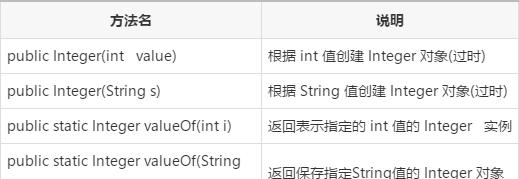环境:
XFire-1.2.6
JDK1.5
MyEclipse 6.5
Tomcat-5.5.27
Windows XP Professional简体中文版
软件下载地址:
[url]http://repository.codehaus.org/org/codehaus/xfire/xfire-distribution/1.2.6/xfire-distribution-1.2.6.zip[/url]
[url]http://apache.mirror.phpchina.com/tomcat/tomcat-5/v5.5.27/bin/apache-tomcat-5.5.27.zip[/url]
有关WebService的概念、原理、数据发现、描述、绑定等过程、方式也不说了。这里就只关注如何快速开发出来一个通用的、易懂的Hello World例子。
以下是开发步骤:
1、创建工程
打开MyEclipse 6.5,新建一个WebService工程。如下图

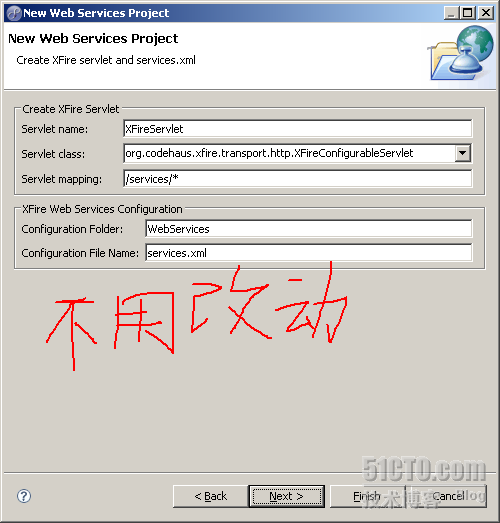
然后一路next,直到完成。
创建完成后,打开生成的web.xml文件,可以看到,XFire已经配置好了。
<?
xml
version
="1.0"
encoding
="UTF-8"
?>
< web-app xmlns ="http://java.sun.com/xml/ns/javaee" xmlns:xsi ="http://www.w3.org/2001/XMLSchema-instance" version ="2.5" xsi:schemaLocation ="http://java.sun.com/xml/ns/javaee [url]http://java.sun.com/xml/ns/javaee/web-app_2_5.xsd[/url]" >
< servlet >
< servlet-name >XFireServlet </ servlet-name >
< servlet-class >org.codehaus.xfire.transport.http.XFireConfigurableServlet </ servlet-class >
< load-on-startup >0 </ load-on-startup >
</ servlet >
< servlet-mapping >
< servlet-name >XFireServlet </ servlet-name >
< url-pattern >/services/* </ url-pattern >
</ servlet-mapping >
< welcome-file-list >
< welcome-file >index.jsp </ welcome-file >
</ welcome-file-list >
</ web-app >
< web-app xmlns ="http://java.sun.com/xml/ns/javaee" xmlns:xsi ="http://www.w3.org/2001/XMLSchema-instance" version ="2.5" xsi:schemaLocation ="http://java.sun.com/xml/ns/javaee [url]http://java.sun.com/xml/ns/javaee/web-app_2_5.xsd[/url]" >
< servlet >
< servlet-name >XFireServlet </ servlet-name >
< servlet-class >org.codehaus.xfire.transport.http.XFireConfigurableServlet </ servlet-class >
< load-on-startup >0 </ load-on-startup >
</ servlet >
< servlet-mapping >
< servlet-name >XFireServlet </ servlet-name >
< url-pattern >/services/* </ url-pattern >
</ servlet-mapping >
< welcome-file-list >
< welcome-file >index.jsp </ welcome-file >
</ welcome-file-list >
</ web-app >
2、创建WebService服务
创建两个个包“wstest.server”和“wstest.client”,用来保存服务端和客户端程序。然后开始创建服务端程序,如下图

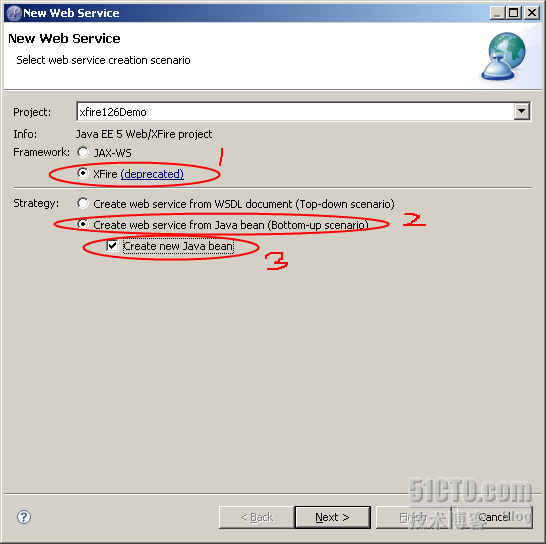
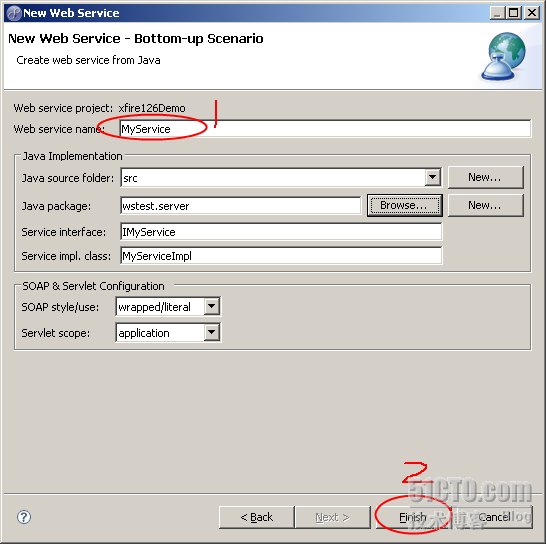
完成后,生成了一个Service的配置services.xml:
<?
xml
version
="1.0"
encoding
="UTF-8"
?>
< beans xmlns ="http://xfire.codehaus.org/config/1.0" >
< service >
< name >MyService </ name >
< serviceClass >wstest.server.IMyService </ serviceClass >
< implementationClass >
wstest.server.MyServiceImpl
</ implementationClass >
< style >wrapped </ style >
< use >literal </ use >
< scope >application </ scope >
</ service >
</ beans >
< beans xmlns ="http://xfire.codehaus.org/config/1.0" >
< service >
< name >MyService </ name >
< serviceClass >wstest.server.IMyService </ serviceClass >
< implementationClass >
wstest.server.MyServiceImpl
</ implementationClass >
< style >wrapped </ style >
< use >literal </ use >
< scope >application </ scope >
</ service >
</ beans >
也生成了接口和默认实现,改写后如下:
package wstest.server;
//Generated by MyEclipse
public interface IMyService {
public String sayHello(String user);
}
//Generated by MyEclipse
public interface IMyService {
public String sayHello(String user);
}
package wstest.server;
//Generated by MyEclipse
public class MyServiceImpl implements IMyService {
public String sayHello(String user) {
return "您好,"+user;
}
}
//Generated by MyEclipse
public class MyServiceImpl implements IMyService {
public String sayHello(String user) {
return "您好,"+user;
}
}
至此,服务端代码已经完成。
3、测试服务端代码
测试依赖与Servlet容器Tomcat,需要将做好的服务端打包部署到tomcat上,然后启动。才可以进行测试。假设你已经配置了Tomcat服务器,并完成了WebService服务端的部署。那么,现在就启动Tomcat,然后:


输入访问地址:
[url]http://localhost:8080/xfire126Demo/services/MyService?wsdl[/url] ,然后go一把!

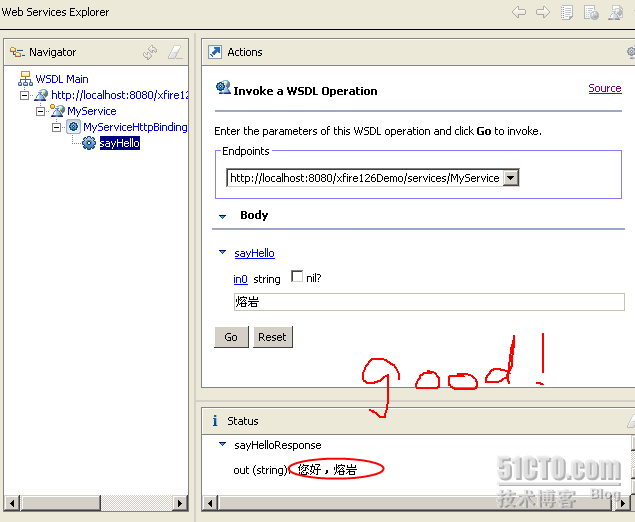
这样,出现上上面的结果,表明测试成功了。
4、生成客户端代码

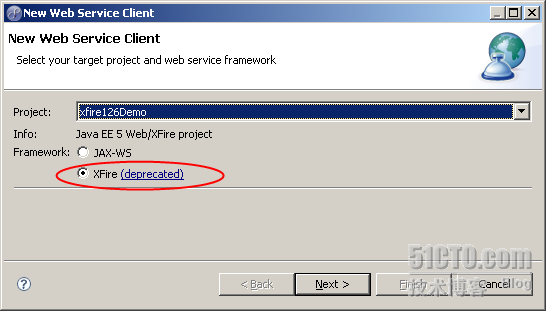
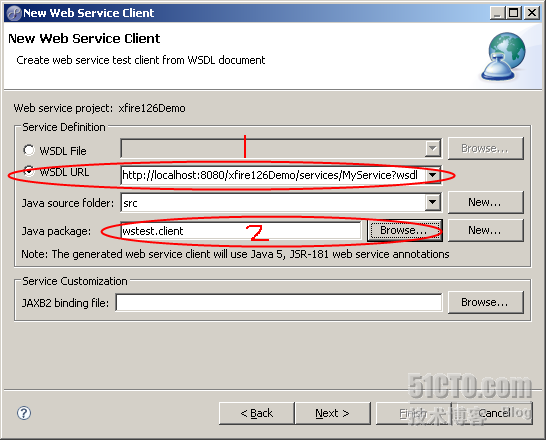

很郁闷,这个生成的客户端代码一部分跑到服务端的包里面了。真是垃圾,rubbish!!!
但是,这就是MyEclipse的功能,我改变不了。
5、客户端测试
下面就耐心看怎么用这个客户端代码。
打开生成的代码如下:
package wstest.client;
import java.net.MalformedURLException;
import java.util.Collection;
import java.util.HashMap;
import javax.xml.namespace.QName;
import org.codehaus.xfire.XFireRuntimeException;
import org.codehaus.xfire.aegis.AegisBindingProvider;
import org.codehaus.xfire.annotations.AnnotationServiceFactory;
import org.codehaus.xfire.annotations.jsr181.Jsr181WebAnnotations;
import org.codehaus.xfire.client.XFireProxyFactory;
import org.codehaus.xfire.jaxb2.JaxbTypeRegistry;
import org.codehaus.xfire.service.Endpoint;
import org.codehaus.xfire.service.Service;
import org.codehaus.xfire.soap.AbstractSoapBinding;
import org.codehaus.xfire.transport.TransportManager;
public class MyServiceClient {
private static XFireProxyFactory proxyFactory = new XFireProxyFactory();
private HashMap endpoints = new HashMap();
private Service service0;
public MyServiceClient() {
create0();
Endpoint MyServicePortTypeLocalEndpointEP = service0 .addEndpoint( new QName( "http://server.wstest", "MyServicePortTypeLocalEndpoint"), new QName("http://server.wstest", "MyServicePortTypeLocalBinding"), "xfire.local://MyService");
endpoints.put(new QName("http://server.wstest", "MyServicePortTypeLocalEndpoint"), MyServicePortTypeLocalEndpointEP);
Endpoint MyServiceHttpPortEP = service0 .addEndpoint(new QName("http://server.wstest", "MyServiceHttpPort"), new QName("http://server.wstest", "MyServiceHttpBinding"), "http://localhost:8080/xfire126Demo/services/MyService");
endpoints.put(new QName("http://server.wstest", "MyServiceHttpPort"), MyServiceHttpPortEP);
}
public Object getEndpoint(Endpoint endpoint) {
try {
return proxyFactory.create((endpoint).getBinding(), (endpoint).getUrl());
} catch (MalformedURLException e) {
throw new XFireRuntimeException("Invalid URL", e);
}
}
public Object getEndpoint(QName name) {
Endpoint endpoint = ((Endpoint) endpoints.get((name)));
if ((endpoint) == null) {
throw new IllegalStateException("No such endpoint!");
}
return getEndpoint((endpoint));
}
public Collection getEndpoints() {
return endpoints.values();
}
private void create0() {
TransportManager tm = (org.codehaus.xfire.XFireFactory.newInstance().getXFire().getTransportManager());
HashMap props = new HashMap();
props.put("annotations.allow.interface", true);
AnnotationServiceFactory asf = new AnnotationServiceFactory(new Jsr181WebAnnotations(), tm, new AegisBindingProvider(new JaxbTypeRegistry()));
asf.setBindingCreationEnabled(false);
service0 = asf.create((wstest.client.MyServicePortType.class), props);
{
AbstractSoapBinding soapBinding = asf.createSoap11Binding(service0, new QName("http://server.wstest", "MyServiceHttpBinding"), "http://schemas.xmlsoap.org/soap/http");
}
{
AbstractSoapBinding soapBinding = asf.createSoap11Binding(service0, new QName("http://server.wstest", "MyServicePortTypeLocalBinding"), "urn:xfire:transport:local");
}
}
public MyServicePortType getMyServicePortTypeLocalEndpoint() {
return ((MyServicePortType)(this).getEndpoint(new QName("http://server.wstest", "MyServicePortTypeLocalEndpoint")));
}
public MyServicePortType getMyServicePortTypeLocalEndpoint(String url) {
MyServicePortType var = getMyServicePortTypeLocalEndpoint();
org.codehaus.xfire.client.Client.getInstance(var).setUrl(url);
return var;
}
public MyServicePortType getMyServiceHttpPort() {
return ((MyServicePortType)(this).getEndpoint(new QName("http://server.wstest", "MyServiceHttpPort")));
}
public MyServicePortType getMyServiceHttpPort(String url) {
MyServicePortType var = getMyServiceHttpPort();
org.codehaus.xfire.client.Client.getInstance(var).setUrl(url);
return var;
}
public static void main(String[] args) {
MyServiceClient client = new MyServiceClient();
//create a default service endpoint
MyServicePortType service = client.getMyServiceHttpPort();
//TODO: Add custom client code here
//
//service.yourServiceOperationHere();
System.out.println("test client completed");
System.exit(0);
}
}
看得很晕,不知道啥意思,但是从“TODO”标记处,我知道了:
//TODO: Add custom client code here
//
//service.yourServiceOperationHere();
//
//service.yourServiceOperationHere();
现在就在这里添加测试代码吧:
//TODO: Add custom client code here
//
//service.yourServiceOperationHere();
String helloString = service.sayHello( "熔岩");
System.out.println(helloString);
//
//service.yourServiceOperationHere();
String helloString = service.sayHello( "熔岩");
System.out.println(helloString);
添加了很傻蛋的两行代码后,就可以运行起来看看测试代码了。
运行结果如下:
您好,熔岩
test client completed
test client completed
终于可以松一口气了。完整的例子跑起来了。
6、总结
总感觉这个开发过程不爽,其实有更好的工具和开发方式:
WebService的编写,比较麻烦的是客户端代码,客户端代码依靠人工去写基本上是不可能的,除非你愿意付出惊人的时间和精力,既便如此也得不偿失。
MyEclipse的客户端开发太差,主要是生成的客户端代码混乱,解决办法是将客户端的编写放到单独一个工程里面来做。
其实,只要服务端编写好了,就完全可以用别的方式根据wsdl的url去生成客户端代码,在这里不得不将一个强大的工具IDEA8推荐出来,IDEA8自带WebService开发工具,插件非常强大,易用。在后面的篇幅中,我会做专门介绍,敬请关注。
当然,MyEclipse也并非一无是处,MyEclipse的服务端调试工具就很不错,很喜欢。提高了开发效率,这也是MyEclipse的过人之处。

